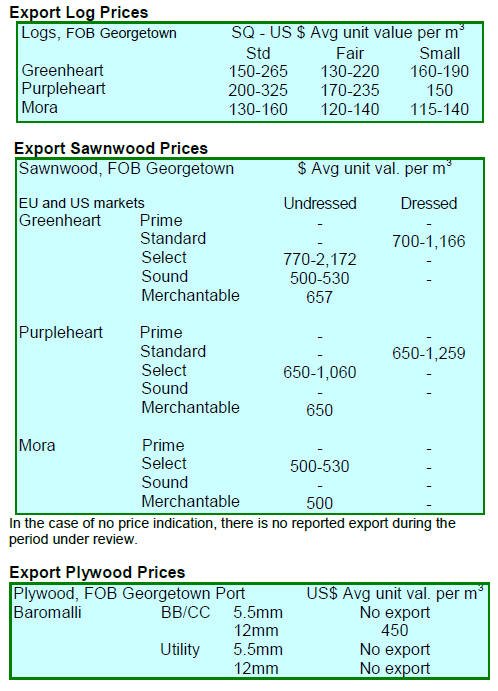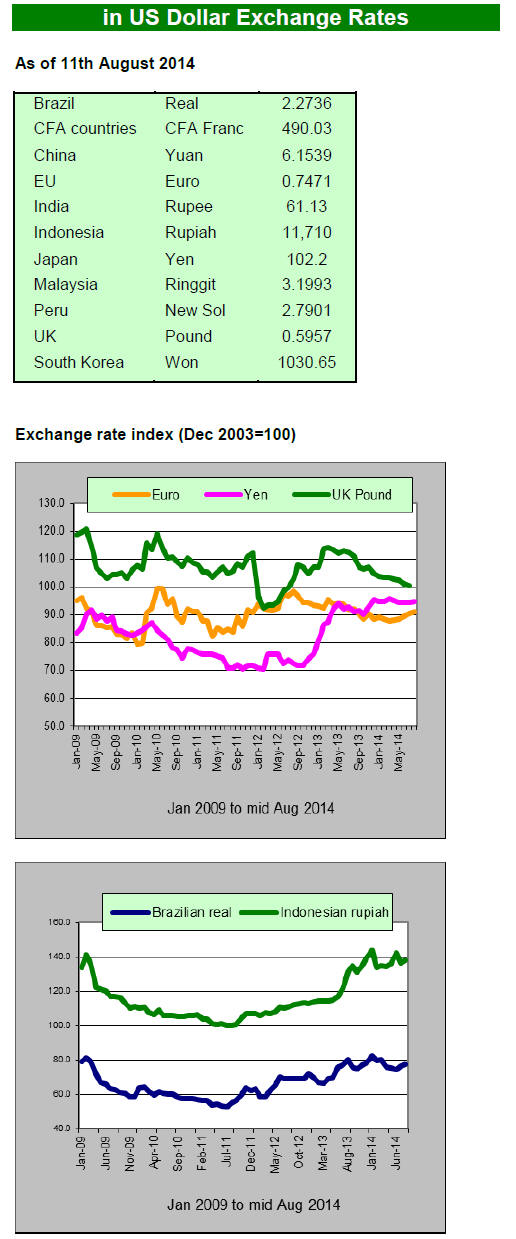2. GHANA
IMF asked to help rebuild the economy
On 8 August the International Monetary Fund (IMF)
Deputy Managing Director, Min Zhu, confirmed the Fund
had received an official request from Ghana for support.
The IMF press statement says: ※Today, IMF Management
received a formal request from the Ghanaian authorities to
initiate discussions on an economic program that could be
supported by the IMF. The Fund stands ready to help
Ghana address the current economic challenges it is
facing.
We expect to send an IMF team to Ghana in early
September to initiate discussions on a program.§
See:
http://www.imf.org/external/np/sec/pr/2014/pr14389.htm
The Ghana government previously announced it would be
looking for IMF support to arrest the decline in the cedi
exchange rate. The cedi has lost around 40% of its value
against the US dollar since the beginning of the year.
Spokespersons from the private sector have warned that an
IMF rescue package always come with tough economic
measures which will affect the lives of everyone in Ghana.
Ghana‟s President, John Mahama, has said Ghana needs
the IMF bailout to rebuild the confidence of international
financial institutions.
Ghana is not alone in having to request support from the
IMF, this year Zambia also took the decision to call on the
IMF for help.
Plans to import timber raw materials
Barbara Serwaa Asamoah, Deputy Minister of Lands and
Natural Resources told participants at recent National
Forest Forum-Ghana that the ministry has proposed
importing timber raw materials from resource rich
countries as domestic resources are insufficient to meet
domestic demand and the demand from industries
processing for export.
The Ghana authorities are apparently in talks with
counterparts in Cameroon and Guyana to find the most
cost effect means to secure timber raw materials.

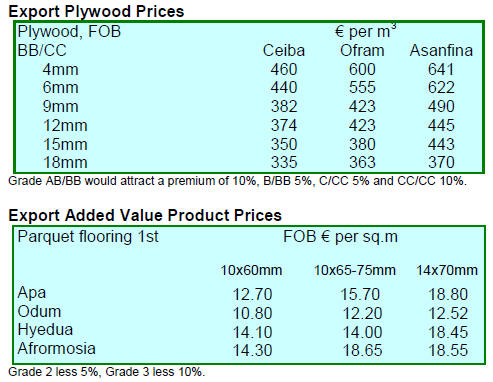
3. MALAYSIA
Drones to detect illegal land clearing
A persistent problem across SE Asia and many other
regions is unauthorised forest clearing by small farmers.
The Malaysia Ministry of Natural Resources and
Environment will establish a joint command centre with
state Drainage and Irrigation Departments to tackle the
problem in Peninsular Malaysia.
Ministry Secretary-General, Zoal Azha Yusoff, has hinted
that unmanned aerial drones may be used to capture
photographs of those illegally clearing the forest.
Performance of rubberwood sawnwood exports
against quota
The Malaysian Timber Export Board has released data on
the first half 2014 exports of rubberwood sawnwood
which is subject to a quota.
The quota for 2014 is set at 80,000 cubic metres and first
half 2014 exports account for 58.5% of the quota leaving a
balance of 37,239 cubic metres for export in the second
half of the year. See:
http://www.mtib.gov.my/

Nearly 10 percent rise in Sabah sawnwood exports
The Statistics Department of Sabah has released export
statistics for the first half of 2014 showing that exports of
sawnwood amounted to 130,360 cu.m valued at
RM195,341,375 (approx US$60.5 million).
By comparison, Sabah exported 118,890 cu.m of
sawntimber for the first half of 2013, worth RM
175,689,389 (approx US$ 54.39 million).
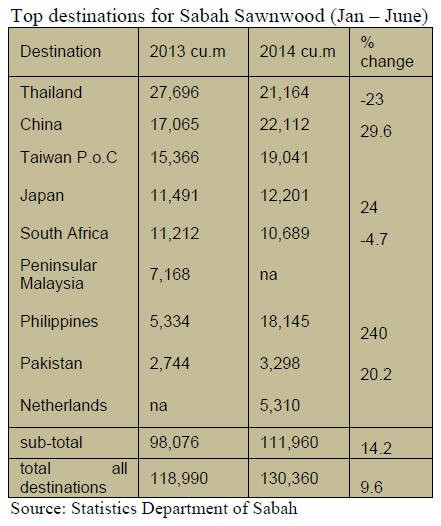
First half plywood exports from Sabah
disappointing
Exports of plywood from Sabah in the first half of 2014
were 280,276 cu.m worth RM473,302,289 (approx.
US$146.53 million).

By comparison, First half 2013 exports were 329,917 cu.m
worth RM510,739,221 (approx US$ 158.12 million, down
15% drop in terms of volume and down 7.2% in value).
Japan and Taiwan P.o.C biggest buyers of Sarawak
plywood
Export statistics for the first half of 2014 compiled by
Sarawak Timber Association show total plywood exports
of 1,176,758 cu.m valued at RM1,989,763,518 (approx.
US$616.0 million).
Japan was the biggest importer accounting for around 60%
of total plywood exports from Sarawak (695,044 cu.m).
Taiwan P.o.C was second biggest buyer at118,655 cu.m
(10% of Sarawak plywood exports) followed by South
Korea at 108,549 cu.m.
In contrast to the situation in Sabah, Sarawak plywood
traders report active business with export orders firming.
Sarawak plywood export prices
Sarawak plywood traders report the following FOB export
prices.
Floor base (FB) (11.5mm) US$ 630
Concrete formboard panels (CP) 3‟x 6‟ US$ 565
Coated formboard panels (UCP) US$ 645
Standard plywood:
Middle East (9 每 18mm) US$ 475
South Korea (8.5 每 17.5mm) US$ 465
Taiwan P.o.C (8.5 每 17.5mm) US$ 465
Hong Kong US$ 470
Sarawak first half log exports
Log export statistics for the first half of 2014 compiled by
Sarawak Timber Association showed a total of 1,487,863
cu.m exported worth RM 1,008,180,715 (approx. US$
312.1 million).
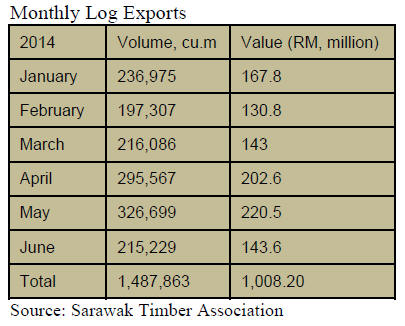
4. INDONESIA
Minister appeals for halt to new
concessions
Forestry Minister Zulkifli Hasan has four issues he wishes
to raise with the new administration.
Zulkifli hopes that the new administration will follow
through on the proposed halt in granting new forest
concessions in primary forests and peat land areas,
something that the state has been trying to do since 2010.
The Minister reported that deforestation has been reduced
from around 3.5 million hectares per year up to 2003 to
only 450,000 hectares per year over the past few years.
Biomass industry offers huge opportunities
The upcoming conference on the biomass pellet trade to be
held in S Korea in September will explore how producer
countries can take advantage of the growing demand for
biomass pellets in China, Japan and South Korea.
The organisers of the conference say producers in New
Zealand, Australia, Vietnam, Indonesia, Malaysia,
Philippines, Canada and the US can profit from the
demand for biomass for energy production.
Indonesia*s APHI calls for lifting ban on log exports
The Indonesian Forest Concessionaires Association
(APHI) is appealing to the new government to allow the
export of logs.
The chairman of APHI, Nana Suparna, said that because
of the log export ban log prices have fallen and that the
current price of logs from the natural forest is only about
half the price of tropical logs in international markets.
In comparison, Nana Suparna said the selling price of
meranti logs in Indonesia‟s domestic market is between
US$120-130 per cubic metre while in the Japanese market
such logs are almost three times that price.
For merbau the local market price is around US$300 per
cubic metre while in the Chinese market merbau sells for
double that price.
Data from the Tropical Timber Market Report indicate
that the wholesale price of merbau sawnwood in China is
as high as US$1400-2200 per cubic metre while
Indonesia‟s FOB price is less than US$600 per cubic
metre.
Indonesia became a major log exporter when, as a result of
a deal with the IMF, log export taxes were reduced but
poor law enforcement resulted in excessive logging
resulting in a ban on log exports in 2001.
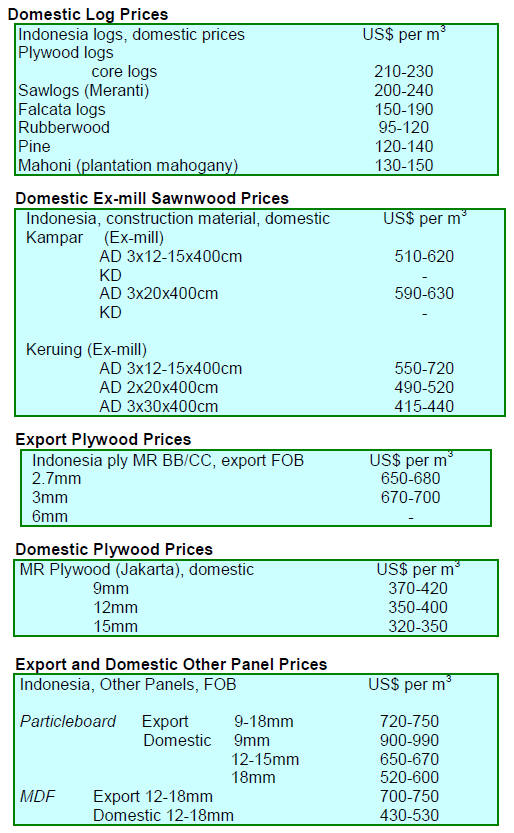
5. MYANMAR
US eases sanctions-door opens for timber
exports
The International Wood Products Association (IWPA) has
issued a press release on the lifting of US restrictions on
timber imports from Myanmar.
See:
http://www.iwpawood.org/associations/8276/files/IWPA%
20RELEASE%20Burma%20Trade%20Initiative%20July
%2028%202014%20CLS.pdf
The IWPA says: ※The United States officially issued a
waiver and general license to ease the ban on imports into
the United States of products from Myanmar.
IWPA has launched an initiative to develop sustainable
wood products trade in Myanmar and has obtained a
specific license for its Voting and Associate members that
enables trade and other commercial contacts between U.S.
wood importers and Myanmar‟s industry and government
agencies involved in the timber trade under certain
conditions.
The license covers all IWPA Voting and Associate
members and the Myanmar Timber Enterprise until July
31, 2015.§
In related news, the IWPA has announced the launch of an
initiative to develop sustainable wood products trade in
Myanmar.
See:
http://www.iwpawood.org/associations/8276/files/IWPA%
20RELEASE%20Burma%20Trade%20Initiative%20July
%2028%202014%20CLS.pdf
Action on smuggling stepped up
The Myanmar press (Eleven Myanmar 9 Aug,) has
reported on the latest statistics from the Forestry
Department on efforts to eliminate the smuggling of
timber.
The report says that during the first quarter of the 2013-14
financial year over 20,000 cubic tons of various species
were seized before they could be smuggled out of the
country.
The timber seized included 5,520 tons of tamalan, 4,500
tons of teak, 1,600 tons of iron wood (pyinkadoe) and over
10,000 tons of other hardwoods.
Authorities arrested 2027 Myanmar and 8 Chinese
nationals and impounded a wide range trucks and logging
equipment. According to Forestry Department data,
428,212 tons of timber was seized over the past ten year
periods.
EIA recommends Myanmar seek CITES protection for
padauk and tamalan
The EIA suggested the Myanmar government seek
protection for padauk and tamalan under the Convention
on International Trade in Endangered Species (CITES) as
these timbers are being illegally over-exploited and
smuggled out of the country.
Analysts in Myanmar say that timber smuggling is the
result of rural poverty, corruption and an understaffed
forest authority.
Proposed new economic zone for Myeik
A new special economic zone (SEZ) is planned for Myeik
in Myanmar‟s southeastern Tanintharyi region, already the
site of other industrial zones.
The proposed new economic zone is a private investment
project and is conveniently located near a harbour which
will be upgraded.
The following are the results of the open tender
sales held
by Myanma Timber Enterprise.
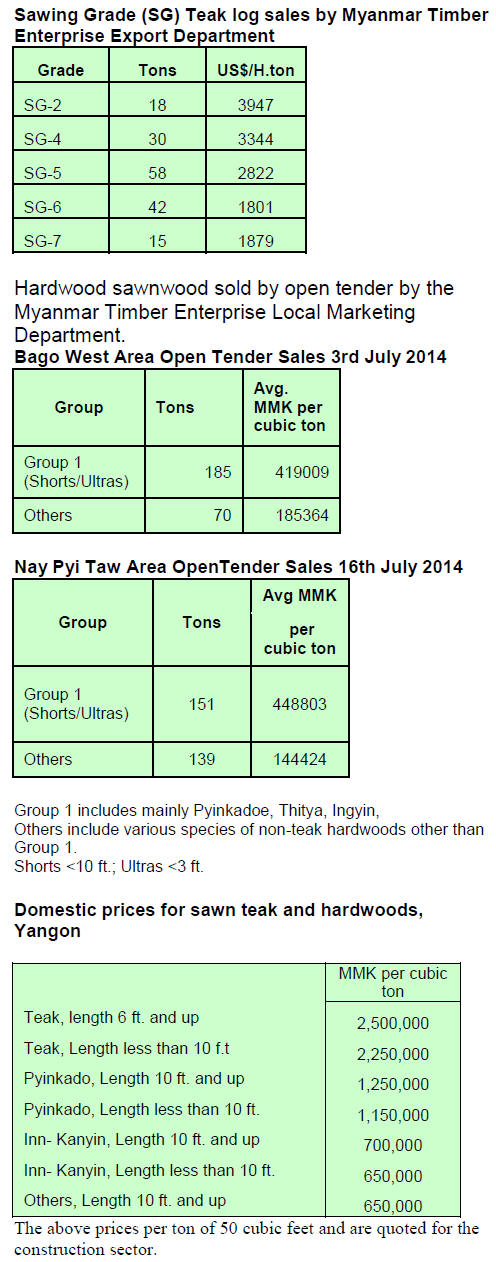
﹛
6.
INDIA
Export growth to support expansion
of manufacturing
In a press release on the Third Bi-Monthly Monetary
Policy Statement, 2014-15, Dr. Raghuram G Rajan,
Governor of the Reserve Bank of India (RBI) says that,
since the last policy statement in June, global economic
activity has been improving after the slowdown in the first
quarter of the year.
This, and the stability brought with the forming of the new
government, has boosted domestic economic activity and
the latest data suggesting industrial output and exports are
reviving.
There was concern that uneven distribution of monsoon
rain would undermine agricultural output but the weather
pattern has stabilised such that the risks to the economy
from a poor post monsoon harvest have been largely but
not entirely, dispelled.
The Governor of the RBI notes the policies of the new
government should create the foundation for an
improvement in domestic demand. In conclusion the press
release says ※Prospects for reinvigoration of growth have
improved modestly. The firming up of export growth
should support manufacturing and service sector activity.§
See:
http://www.rbi.org.in/scripts/BS_PressReleaseDisplay.asp
x?prid=31773
Real estate investment a major contributor to GDP
CREDAI newsletter of 15 July introduces the results of the
latest real estate survey „Importance of Real Estate
Services and Housing: Economic Survey 2013‟.
The report notes that the pace of private real estate
ownership grew by 5.6 per cent in 2012 and that estimates
show that for every rupee invested in housing and
construction 78% of that investment makes a direct
contribution to GDP expansion.
For full report: http://www.credai.org/real-estate-servicesand-
housing-indian-economy-economic-survey-2013-14
Affordable housing defined
In related news CREDAI has reported that ※Affordable
housing loans are defined as housing loans to individuals
up to Rs. 50 lakhs (Rs. 5,000,000) for houses of values up
to Rs. 65 lakhs (Rs.6,500,000) located in the six
metropolitan centres Mumbai, New Delhi, Chennai,
Kolkata, Bengaluru and Hyderabad and Rs. 40 lakhs
(Rs.4,000,000) for houses of values up to Rs. 50 lakhs (Rs.
5,000,000).
In other cities the RBI has indicated it will periodically
review the definition of affordable housing on account of
inflation.§
See: http://www.credai.org/rbi-circular-issue-long-termbonds-
banks-financing-infrastructure-and-affordablehousing
Teak auctions postponed until end of monsoon
The last of the log auctions before the monsoon weather
makes them impossible have been concluded. The
monsoon rains have begun in all areas in Central India so
the next auctions will be held only when the dry season
begins.
At the latest auctions average prices have been Rs.50 to
Rs.75 per cubic foot higher for high quality log lots.
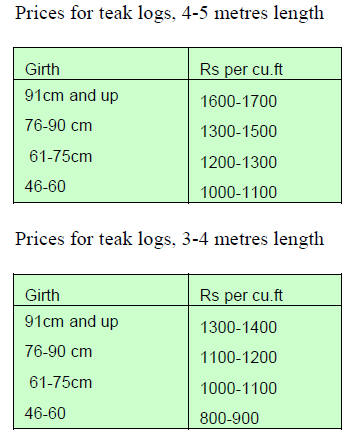
Plantation teak sales to get a boost
Prices for imported plantation teak logs and squares are
unchanged but the weakening of the rupee, if sustained,
will sap the confidence of importers. However, with the
monsoon in full swing sales of imported teak are expected
to increase simply because harvesting of domestic teak has
stopped until the end of the monsoon.
Current C & F prices for imported plantation teak, Indian
ports per cubic metre are shown below.
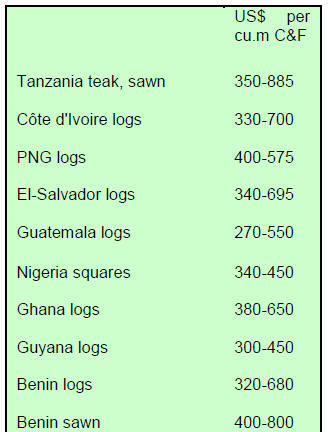
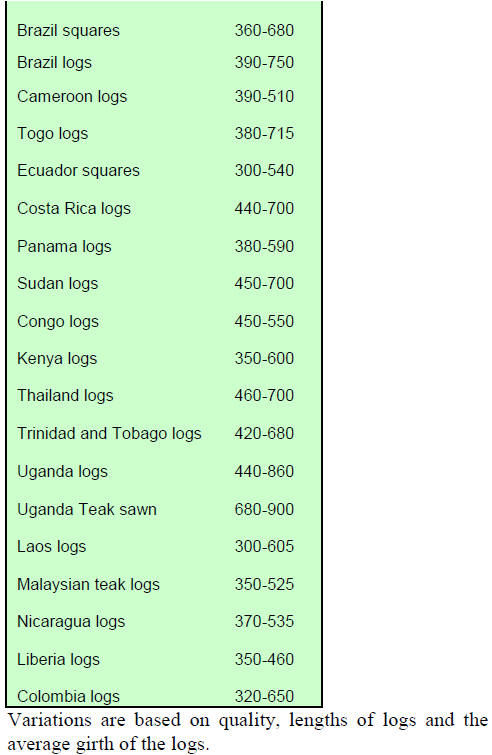
Exmill prices for sawnwood
The weakening of the rupee has impacted prices for
sawnwood cut from imported logs.
Prices for air dry sawnwood per cubic foot, ex-sawmill are
shown below.
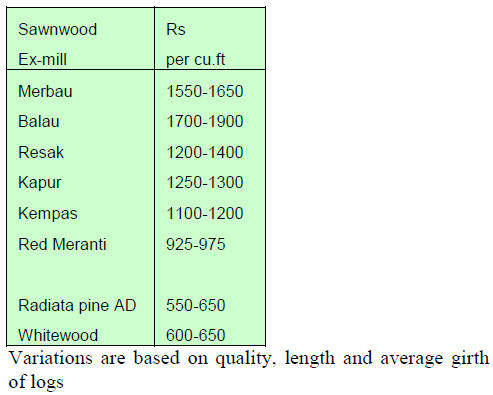
Cash payments for Myanmar teak
The domestic market for Myanmar teak has changed with
each trader now fixing prices depending on stock levels
irrespective of the price other traders are offering.
Previously the India teak trade was commonly on a
credit
basis but now, because supplies are limited, buyers of
Myanmar teak must pay cash or provide a L/C (Letter of
Credit).
Those with teak log stocks are unconcerned that not all
buyers can pay with cash up-front as stockists know the
supply situation can only become more severe as stocks of
imported Myanmar teak are sold off.
No-one has yet dared to anticipate what will happen in the
teak market when all the stocks of Myanmar logs have
been sold.
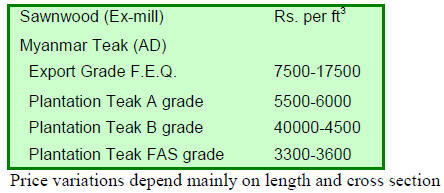
Imported sawnwood prices
Ex-warehouse prices for imported kiln dry (12% mc.)
sawnwood per cu.ft are shown below.
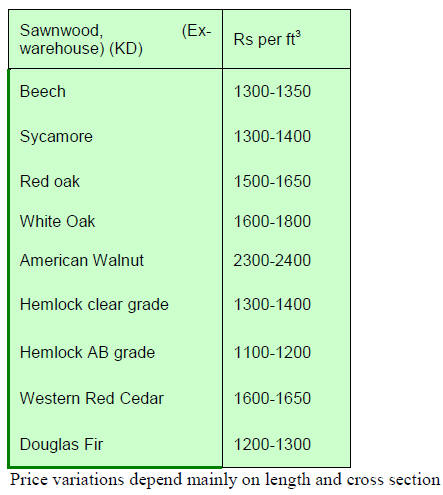
Plywood prices
The government‟s „Houses for Everyone‟ has been
welcomed by plywood manufacturers. The latest
information is that homes built under the government
programme will now be of a minimum 30 square metres,
up from the previous 20 square metre standard which will
create higher consumption of plywood.

﹛
7.
BRAZIL
Mahogany plantations for Brazil
Interest in mahogany (Khaya senegalensis, dry zone
mahogany) plantations is growing in Brazil. This dry zone
mahogany is a medium sized tree which grows relatively
fast. This species has shown to adapt well to various
edaphic and climatic conditions in Brazil.
The Brazilian Institute of Forests (IBF) is encouraging
plantation development through provision of material for
the production of seedlings and is also providing technical
support. IBF says the trees can be harvested after 15 years
after planting and that the return on investment is
potentially high.
Satellite monitoring of logging
Forest areas under Sustainable Forest Management Plans
(PMFS) in Mato Grosso State will soon be monitored by
the State Secretary of the Environment (SEMA) using
satellite remote sensing.
The forest cover monitoring will be carried out through an
agreement between SEMA and the Center for Timber
Industry Producers and Exporters of Mato Grosso
(CIPEM). CIPEM will provide technical, logistical and
technological support and SEMA will make available
analysts for assessing and monitoring of the data collected.
The forest sector is very important for the economy in
Mato Grosso State as the sector generates thousands of
jobs, income and tax revenues.
The Mato Grosso State Industries Federation (FIEMT) has
suggested the creation of a specific department for the
forest sector within the state government to promote
further development of production.
Woodbased panel exports rise in first half 2014
According to Brazilian Industry of Trees (IBÁ), the
volume of woodbased panel exports in the first half of this
year totalled 251,000 cu.m, a 22% increase compared to
the same period of 2013.
Year-to-date, woodbased panel imports totalled 453,000
cu.m, a 40% decline compared with the same period in
2013.
According to the Ministry of Development, Industry and
Foreign Trade (MDIC), exports of tropical sawnwood
dropped from 174,700 cu.m between January and June
2013 to 160,200 cu.m in the first half of this year, a 9%
decline.
Tropical sawnwood imports fell 45% in the first half of
2014 compared to the same period of 2013, (14,000 cu.m
in 2013 to 9,700 cu.m in 2014).
APEX-Brazil promotes furniture exports at Form車bile
Fair
The ※Project Orchestra Brazil§, promoted by the Union of
Furniture Industry of Bento Gonçalves (Sindm車veis) with
support from the Brazilian Agency for Export and
Investment Promotion (Apex-Brazil), participated in the
International Fair for the Wood and Furniture Industry
Suppliers 每 Form車bile 2014.
Prospective buyers came from South Africa, Argentina,
Canada, Colombia, Costa Rica, Mexico, Peru, Puerto Rico
and Uruguay.
The Project Orchestra Brazil, created in 2006, promotes
the participation of Brazilian furniture enterprises in
international markets.
Currently there are 72 companies and 38 furniture design
studios participating in the project. Exports of
participating companies increased almost 15% 2013
compared to the previous year marking four consecutive
years of growth.
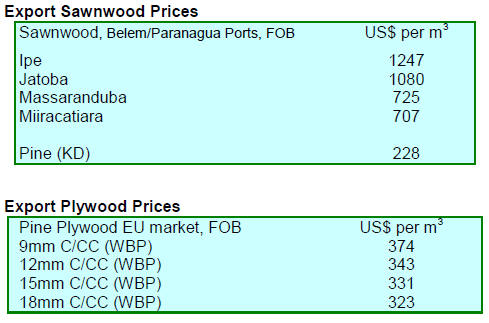
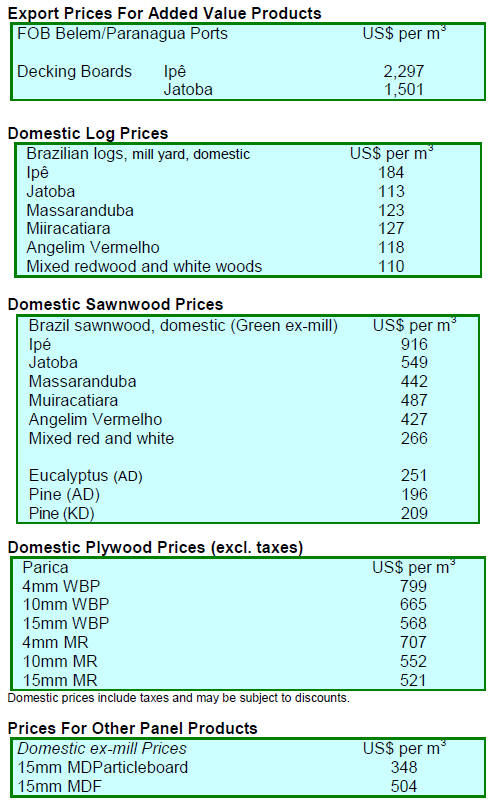
8. PERU
Strengthening OSINFOR and Regional
Administrations
Fabiola Muñoz, Head of the General Directorate of
Forestry and Wildlife has declared that it is necessary to
strengthen the forestry watchdog (OSINFOR) and
Regional Governments to effectively combat illegal
logging in the country. He complained that of the current
630 timber concessionaires only about a third are
following the agreed management plans.
New national forest and wildlife service launched
The Ministry of Agriculture and Irrigation (MINAGRI)
reported that it has inaugurated a new specialised agency,
Forestry and Wildlife Service National (SERFOR), which
is charged with ensuring the application of sustainable
management practices in the country.
SERFOR is responsible for developing rules, procedures,
plans, strategies and guidelines for the sustainable
utilisation of forest and wildlife resources.
The New Forest National Wildlife Authority and was
created by Act has Nº29763 Regulation and Organization
Functions (ROF).
SERFOR replaces the Forest and Wildlife Department and
will have its own budget and management structure to
ensure it becomes a world class agency promoting the
rational utilisation of forests and wildlife resources
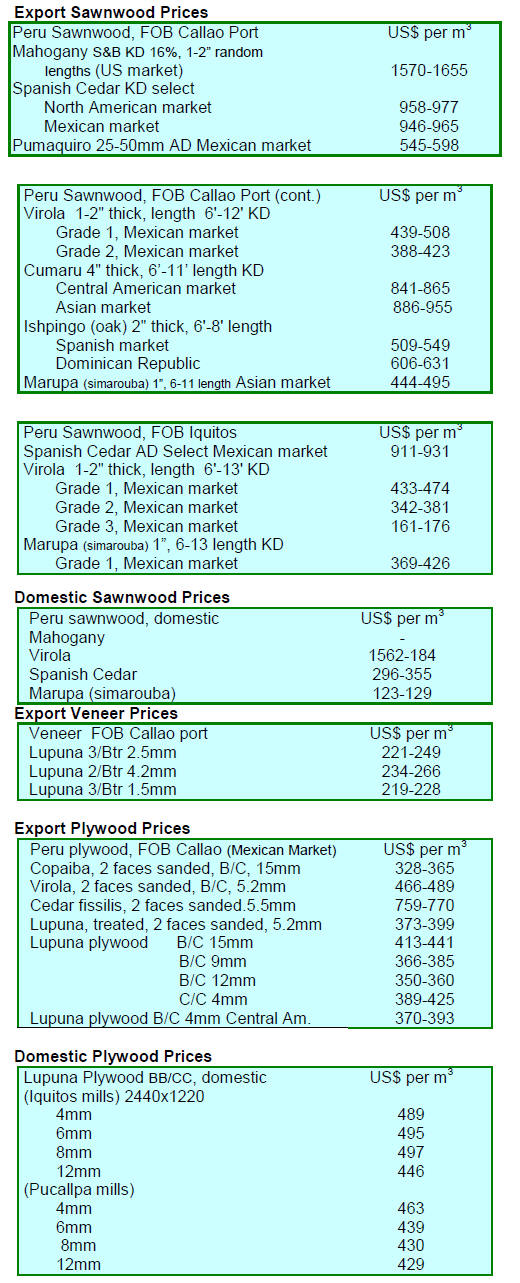
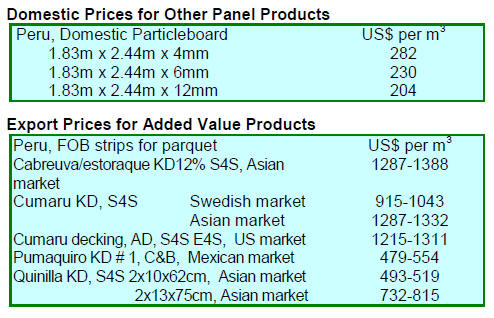
﹛
9.
GUYANA
s.First half exports
First half 2014 wood product exports were worth US$21.8
mil. while first half 2103 exports totaled US$16.9 mil.
Exports of seven products account for over 90% of
Guyana‟s international trade in wood products which grew
by 51% in 2014 compared to the first half of 2013.
Log exports rose 80% and account for over 70% of all
wood product exports. A significant improvement was
recorded in exports of wallaba poles and posts, mainly to
Caribbean markets. Sawnwood exports in the first half of
2014 were higher than in the same period in 2013 but only
by a small margin.
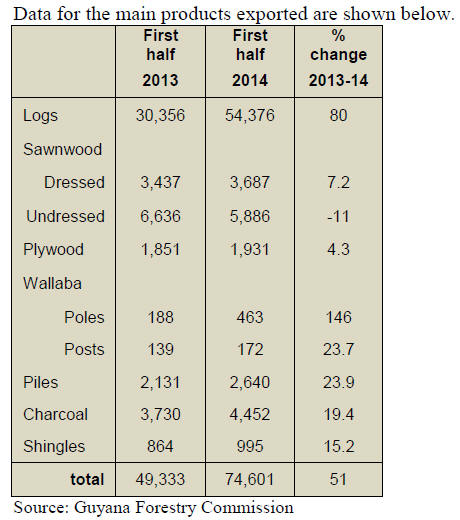
Of the wide range of added value products exported,
wooden doors and mouldings contributed the most to first
half 2014 export earnings.
